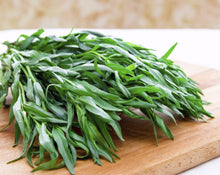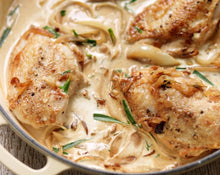Tarragon:
Tarragon is a perennial herb that is a staple of French cuisine. This herb makes a great addition to savory dishes that include tomatoes, mushrooms, fish and poultry. It is also a popular addition to sauces, salad dressings and flavored vinegar. Plants average 24″ tall and produce narrow green leaves. In the warmer months, plants will produce small white flowers.Tarragon leaves may be used fresh or allowed to dry,
Medicinal History
Tarragon has numerous health benefits, many of which can be derived by consuming the plant leaves fresh or through a fresh leaf infusion in water or vinegar; others are produced by pharmacological extraction. Historically it had numerous uses for various cultures, some of which continue to be used today.
Arabic: Tarragon was used as an aid for insomnia as well as to enhance the taste of unpleasant medicines. Furthermore, it was used as an anesthetic for throbbing teeth, skin sores as well as cuts (Obolskiy, D., et al., 2011). Arabic herbalists also used it as a breath freshener (Charles, D.J., 2013).
Asia
Russia: Tarragon was used in the treatment of topical skin wounds, reducing inflammation and irritation. It was also used in treating allergic reactions that would occur on the skin (Obolskiy, D., et al., 2011). It was also used in Russia before in the treatment of scurvy, to reduce the convulsions as a result of epilepsy and as a treatment for night blindness (Roy, H.J., n.d.).
China: Chinese Traditional Medicine (TCM) uses tarragon as a protector and strengthener of the liver, as well as a diuretic. They also use it to aid in reducing topical skin inflammation (Roy, H.J., n.d.). The other uses the TCM has for the little dragon include the following; use for microbial infections, inflammatory diseases, malaria, hepatitis, gastric ulcers, cancer, diarrhea and circulatory diseases (Charles, D.J., 2013).
Chippewa: This Aboriginal group used tarragon for gynecological reasons, so as to reduce menstrual blood flow as well as to aid with difficult births. They would chew the leaves to ease heart palpitations and would bath youth and elderly in tarragon bath/steam baths to bring more strength into the body. (Obolskiy, D., et al., 2011).
Shuswap: This Aboriginal group used this delicate herb as a way to keep away mosquitos – mosquito repellent (USDA, 2001).
Ramah Navaho: This Aboriginal group would turn tarragon into a salve for which they would treat and heal wounds (USDA, 2001).
Europe
Middle-Ages: It was during this time that the therapeutic properties of tarragon were discovered in Europe. It moved past its culinary skills and began to be used for the treatment of fever, upper respiratory infections, digestive problems, ulcers, as a means to stimulate appetite as well as to reduce plaque epidemics (Roy, H.J., n.d.).
North America
Chippewa: This Aboriginal group used tarragon for gynecological reasons, so as to reduce menstrual blood flow as well as to aid with difficult births. They would chew the leaves to ease heart palpitations and would bath youth and elderly in tarragon bath/steam baths to bring more strength into the body. (Obolskiy, D., et al., 2011).
Shuswap: This Aboriginal group used this delicate herb as a way to keep away mosquitos – mosquito repellent (USDA, 2001).
Health Benefits and Properties
Tarragon has been used therapeutically to treat ailments for centuries, from malaria to liver diseases, to reducing bodily inflammation. It is best known for its essential oils/volatile oils, which has been shown to provide anti-cancer, anti-inflammatory and antiseptic properties among many others (Obolskiy, D., et al., 2011) (Craig.W.J.. 1997) (Roy, H.J., (n.d)).
The essential oil of this bitter, sweet herb contains numerous plant secondary compounds, such as; coumarins, flavonoids, phenolic acid, polyacetylene derivatives and, as a whole contains approximately 69 distinct compounds. There are two peak times for when the oil of tarragon is at its highest. The first being during the beginning of the budding stage of the plant often in the early spring and the latter during the beginning of the plants flowering. Climate and region affect the quality and potency of the oil content as well (Obolskiy, D., et al., 2011) (Nurzynska -Wierdak, R., & Zawislak, G., 2014).
Tarragon contains numerous other beneficial components such as phenols, vitamins, and tannins, all of which are beneficial in aiding in healing and balancing the body. The wonderful thing about using the whole herb, especially when it is fresh is that its effect will not be singular on the body. It will not positively affect one single organ or system instead it will work on the body as a whole bringing it closer to equilibrium, balance, and health.
Below is a representation of the nutritional proportions of dried tarragon. The fresh herb will have higher proportions of nutrients and plant secondary compounds within it, therefore make sure to always go with fresh tarragon when cooking or making tonics.




